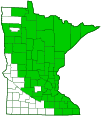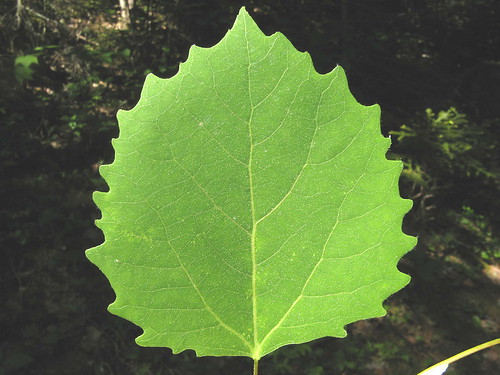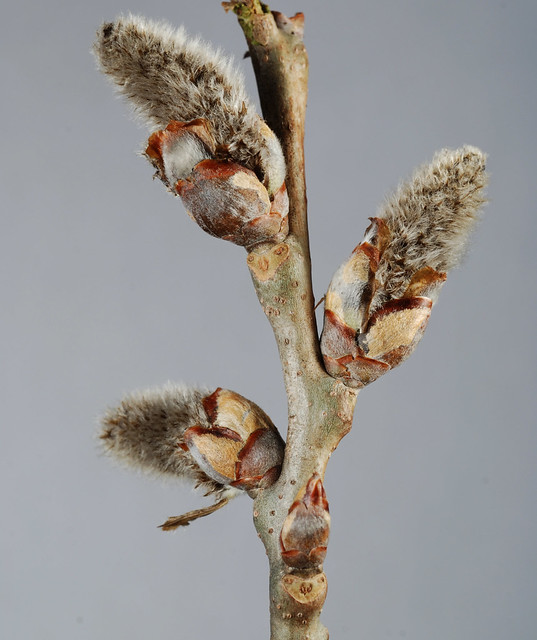bigtooth aspen
(Populus grandidentata)
Conservation • Wetland • Description • Habitat • Ecology • Use • Distribution • Taxonomy
Description |
||
Bigtooth aspen is a fast growing, short lived, deciduous, hardwood tree. It rises on a single stem from a shallow, wide-spreading root system. Reproduction is usually from root suckers, and seedlings are rare. It is usually found as a stand of 12 to 24 clones. Mature trees in the state are usually 40′ to 60′ tall and 10″ to 12″ in diameter at breast height. On poor sites stands begin to deteriorate in 40 to 45 years. On favorable sites stands will begin to deteriorate after 50 to 70 years. Large individuals can reach 90′ in height and 24″ in diameter and last more than 100 years. The trunk is straight, slender, and free of branches on the lower part. The branches are short, stout, and ascending. The crown is short, open, and rounded. The bark on young trees is smooth and olive green or grayish-green, sometimes with an orangish cast. It is darker than the bark of quaking aspen and does not peel like paper birch. As it ages it becomes olive-green near the top of the tree and thick and dark gray with deep furrows and flat ridges near the base of the tree. The current-season twigs are stout, dull, grayish- or reddish-brown with orange dots (lenticels). They are downy when the leaves are unfolding, becoming hairless by the end of the first year. They are round in cross section and have white, star-shaped pith. They turn gray and rough in the second year. Terminal buds are reddish-brown to gray, about ¼″ long, egg-shaped, and blunt pointed. They are covered with fine, whitish hairs giving them a dusty appearance. They are not aromatic. Lateral buds are similar but slender, point away from the twig, and have 3 or visible scales. The leaf scars are raised and triangular with 3 bundle scars. The leaves are deciduous, alternate, and not lobed or divided (simple). They are attached to the twig on 1½″ to 3″ long leaf stalks. The leaf stalk is shorter than the leaf blade and is flattened, at least near the base. The leaf blade is firm, broadly egg-shaped to almost round, 2″ to 4″ long, and 1¾″ to 3½″ wide. They are 1.0 to 1.3 times as long as wide. They are rounded or somewhat squared off at the base and taper to a short point at the tip. They unfold 7 to 10 days later than leaves of quaking aspen. When unfolding the leaves are densely covered with white, wooly hairs. When they mature the upper surface is dark green, waxy, and hairless. The lower surface is paler green and remains hairy somewhat longer. The margins have 6 to 15 large, sharp or blunt teeth per side. In autumn the leaves turn yellow and orange. Male and female flowers are borne on separate trees. They appear before the leaves in early late mid-April to mid-May. Both male and female flowers are borne in crowded, pendulous, stalkless catkins on 2nd year branchlets. Male catkins are 1″ to 3½″ long, female catkins are 1¼″ to 3⅛″ long. Female catkins elongate when fruiting, becoming 3½″ to 5⅞″ long. The fruit is an egg-shaped, ⅛″ to 3 ⁄16″ long, 2-valved capsule. Each capsule contains numerous seeds. The seeds are released late May to mid-June. They have cottony hairs attached and are dispersed by wind. |
||
Height |
||
40′ to 90′ |
||
Record |
||
The champion bigtooth aspen in Minnesota is on private property near Sandstone, in Kanabec County. In 2018 it was measured at 111′ tall and 116″ in circumference (37″ in diameter), with a crown spread of 54′. Bigtooth aspen is also a champion tree in the National Champion Tree Register. |
||
Flower Color |
||
Reddish or greenish-yellow |
||
Similar Species |
||
White poplar (Populus alba) leaves are palmately lobed and remain densely white-hairy on the underside at maturity. All other Populus species in Minnesota have hairless buds and smaller teeth on the leaf margins. |
||
Habitat |
||
Moist. Uplands. Full sun. |
||
Ecology |
||
Flowering |
||
Late mid-April to mid-May |
||
Pests and Diseases |
||
|
||
Use |
||
|
||
Distribution |
||||
|
Sources |
|||
| 2/20/2023 | ||||
Nativity |
||||
Native |
||||
Occurrence |
||||
Common |
||||
Taxonomy |
|||
| Kingdom | Plantae (Plants) | ||
| Division | Tracheophyta (Vascular Plants) | ||
| Subdivision | Spermatophytina (Seed Plants) | ||
| Class | Magnoliopsida (Dicots) | ||
Order |
Malpighiales (Nances, Willows, and Allies) | ||
Family |
Salicaceae (Willow) | ||
| Subfamily | Salicoideae | ||
| Tribe | Saliceae | ||
| Genus | Populus (poplars, cottonwoods, and aspens) | ||
| Section | Populus (aspens and allies) | ||
Synonyms |
|||
Populus grandidentata var. angustata Populus grandidentata var. meridionalis Populus grandidentata var. subcordata |
|||
Common Names |
|||
American aspen aspen bigtooth aspen Canadian poplar large poplar large-tooth aspen large-toothed poplar poplar white poplar |
|||
Glossary
Catkin
A slim, cylindrical, drooping cluster of many flowers. The flowers have no petals and are either male or female but not both.
Lenticel
A corky, round or stripe-like, usually raised, pore-like opening in bark that allows for gas exchange.
Simple leaf
A leaf that is not divided into leaflets, though it may be deeply lobed or cleft.
Sucker
A basal shoot rising from the roots or from a bud at the base of a shrub or tree.
Visitor Photos |
|||||
Share your photo of this plant. |
|||||
| This button not working for you? Simply email us at info@MinnesotaSeasons.com. Attach one or more photos and, if you like, a caption. |
|||||
Randy |
|||||
Bigtooth Aspen leaf, Freeborn County, Minnesota, October 2017 |
|||||
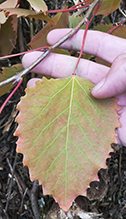 |
|||||
Big-tooth aspen branching |
|||||
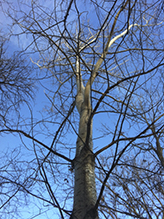 |
|||||
Big-tooth aspen bark |
|||||
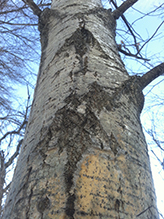 |
|||||
MinnesotaSeasons.com Photos |
|||||
Tree |
|||||
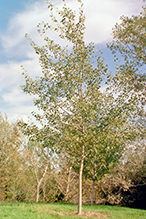 |
|||||
Sapling |
|||||
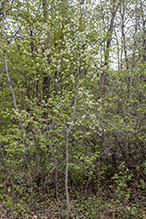 |
|||||
Leaves |
|||||
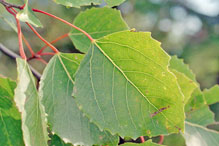 |
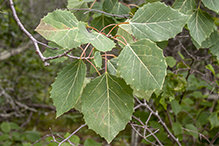 |
||||
Young Leaves |
|||||
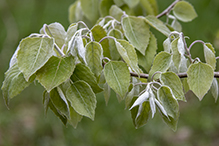 |
|||||
Bud |
|||||
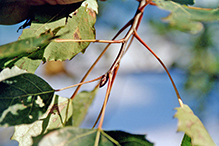 |
|||||
Young Bark |
|||||
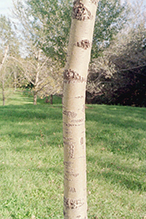 |
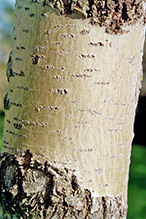 |
||||
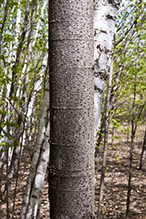 |
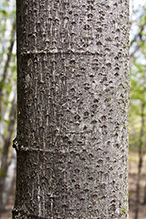 |
||||

Visitor Videos |
|||
Share your video of this plant. |
|||
| This button not working for you? Simply email us at info@MinnesotaSeasons.com. Attach a video, a YouTube link, or a cloud storage link. |
|||
Other Videos |
|||
| Bigtooth Aspen seeding Bud Tristano |
|||
About
Published on Jun 4, 2013 Bigtooth Aspen (Populus grandidentata) - May 2013, Northwest Pennsylvania. These trees "broadcast" their seeds via the open air, from catkins, which hang from the branches. The wind causes many of the catkins to detach and fall to the ground. Some are still effective as they land in branches of other trees and are still susceptible to the open air. The seeds themselves are attached to small cottony fibers which enable them to float and cast their fate to the wind. |
|||
| Trees with Don Leopold - bigtooth aspen ESFNature |
|||
About
Published on Dec 12, 2013 Don Leopold demonstrates the characteristics of bigtooth aspen. Content produced by Christopher Baycura for the SUNY College of Environmental Science and Forestry (SUNY-ESF). |
|||
| Big tooth Aspen identification video wvoutdoorman |
|||
About
Published on Sep 10, 2013 Big tooth Aspen identification video |
|||

Visitor Sightings |
|||||
Report a sighting of this plant. |
|||||
| This button not working for you? Simply email us at info@MinnesotaSeasons.com. Be sure to include a location. |
|||||
| Randy October 2017 |
Location: Freeborn County, Minnesota Bigtooth Aspen leaf |
 |
|||
| Randy 12/22/2016 |
Location: Freeborn Co. Big-tooth aspen branching |
 |
|||
MinnesotaSeasons.com Sightings |
|||||
Avon Hills Forest SNA, North Unit Bertram Chain of Lakes Regional Park Charles A. Lindbergh State Park Lake Alexander Woods SNA, South Unit Mary Schmidt Crawford Woods SNA Nerstrand Big Woods State Park Sand Prairie Wildlife Management and Environmental Education Area |
|||||

|
Created: Last Updated: © MinnesotaSeasons.com. All rights reserved. |
